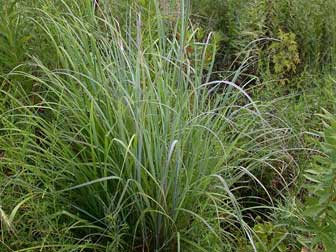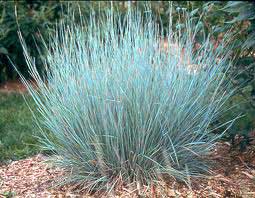Big Bluestem Grass
What is Big Bluestem?
Big Bluestem is a tall grass native to much of the prairie and Great Plains regions of North America. It is one of the most tolerant grass types to a wide range of moisture levels and soil types. Depending on the growing environment, it can reach heights of up to 3-10 feet!
The base of the Bluestem grass turns to a purplish-blue color as it matures. The bluestem is sometimes referred to as the 'turkey foot' due to the seed heads having three spike-like projections. The grasses roots are deep, and the plants send out strong, tough rhizomes, resulting in an extremely strong sod. Big bluestem is also called simply 'tall grass'. It is also a Perennial Grass type.

Planting Big Bluestem Grass
Bluestem is fairly adaptable and easy to plant. Spread the seed over the desired planting area and spread a thing layer of soil overtop of them. Do not make the soil thick. Keep the seeds moist during the germination processes. Do not use fertilizer when planting Big Bluestem. You should notice the grass in about 3-4 weeks depending on adequate soil conditions (moisture and temperature). The ideal time to Plant Big Bluestem is Early Spring and Mid Fall for the Pennsylvania region.
Thinking of added Bluestem to your Lawn?
Bluestem is not a good lawn grass. Bluestem's primary use is as an ornamental grass or for restoration in prairie areas. If you are having a problem with Bluestem in your lawn and need to remove it, the easiest way is to mow it low enough (approximately 1 - 1 1/2 inches) so the other species of grass may dominate and slowly kill it off.

Big Bluestem Cultivation.
The preference is full to partial sun and slightly moist to dry conditions. Various kinds of soil are tolerated, including those that can loam, clay-loam, sand, and gravel. Most growth and development occurs during the warm weather of summer because of the C4 metabolism of this grass. It can spread aggressively in some situations (e.g., prairie restorations).
Big Bluestem Ecology.
Big Bluestem is a late-successional grass in prairie ecosystems. It grows in tall, dense stands that shade out other plant species. "These stands tend to gradually increase in size over time, unless a disturbance (such as overgrazing, or lack of grazing) allows other plant species to re-establish themselves.
Use of Big Bluestem
As Landscapers, we use Bluestem as an ornamental grass to add color and life to flower beds, hill sides, or to provide a cover for non-attractive areas.
Bluestem, which has many variants, is considered to be good forage for horses and cattle, and can also be cut and used for hay. It has a high protein level. While not considered the highest quality native forage found in the United States, it has long been considered a desirable and ecologically important grass by cattle ranchers and range-land ecologists. Due to its high biomass, big bluestem is being considered as a potential feedstock for ethanol production.
Big Bluestem Specifications.
Type: Perennial.
Mature Height: 4 - 7 feet.
Soil Type: 2-3 feet.
Mature Spread: 2-3 feet.
Flower Color: Purplish.
Mature Form: Upright - Clump.
Foliage Color: Silver-blue.
Growth Rate: Moderate.
Fall Color: Reddish copper.
Sun Exposure: Full sun.
Moisture Requirements: Adaptable to dry.
